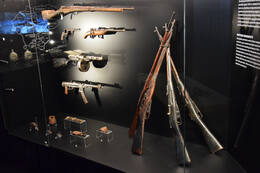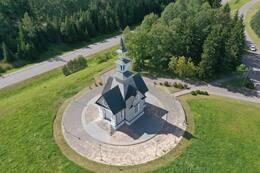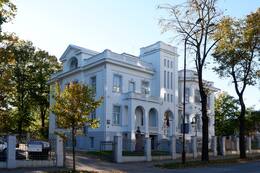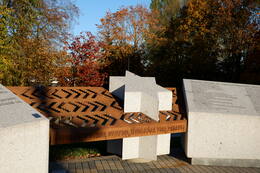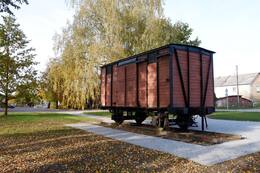Sovietinės Lietuvos paveikslas
Day 3.
160 km
Telšiai – Šiauliai – Radviliškis – Panevėžys
Practical info
- Maršruts ir domāts kā padomdevējs - kā optimālāk apceļot reģionu vai valsti, vai divas valstis ar mērķi iepazīt to militāro mantojumu;
- Braucējam pašam ir jāizplāno – cik no ieteiktajiem objektiem un vietām viņš vienas dienas laikā var iepazīt;
- Pirms ceļojuma ir jānoskaidro apskates vietu (muzeju, kolekciju, fortifikācijas u.c. objektu) darba laiks;
- Vietās, kur ir iepriekšēja pieteikšanās (vietējie gidi, privātas kolekcijas, cits), ir jāpiesaka vizīte, norādot datumu un laiku. Ja ceļojums tiek atcelts, ir jāinformē pieteiktās vietas;
- Naktsmītnes ir jārezervē laicīgi. Vasaras sezonā, īpaši jūras piekrastē naktsmītnes var būt nepieejamas. Daļa no ēdināšanas uzņēmumiem ziemas sezonā var nestrādāt;
- Ceļojumam izvēlieties ne tikai vasaru, bet arī citus gadalaikus;
- Latvijas – Lietuvas – Igaunijas robežas pa autoceļiem var šķērsot brīvi bez ierobežojumiem un jebkurā diennakts laikā. Iebraucot no vienas valsts otrā ir jābūt līdzi ID kartei vai pasei;
- Apmeklējiet tūrisma informācijas centrus, kur var iegūt papildus informāciju, bukletus, kartes.
Sights
Samogitian Museum "Alka"
The museum is located in the city of Telšiai, on the north-western coast of Lake Mastis.
in 2024 In September, after the reconstruction, the newly opened Žemaitia Museum "Alka" presents the history and culture of the Žemaitija region - archaeological finds, rare and unexpected historical artifacts, ethnographic treasure, the legacy of interwar and emigrant artists, the exclusive heritage of Žemaitija estates: historical furniture, masterpieces of art.
Three exhibition spaces are particularly interesting from the perspective of military heritage:
1. The audio-visual installation "Epochų lůmis" which is complemented by a small exposition of artifacts from the Second World War. The exclusive exposition, divided into two parts, displays authentic items used by soldiers during the Nazi German and Soviet occupations - helmets, ammunition boxes, bayonets, and relevant video projections.
2. "Loss stories" in which the painful part of the nation's history is told through the stories and destinies of different individuals and families, determined by the brutal Soviet occupation regime's terror against the local population.
3. "Guerrilla War in Žemaitija" exposition is arranged in a stylized reproduction of the interior of a post-war partisan hideout. In the exhibition, you can familiarize yourself with the structure of the Lithuanian partisans, see authentic artifacts found at the site of the Battle of God's Seat Forest near Telšiai, as well as examples of weapons typical of that period, an excerpt from a documentary film dedicated to this battle, and various photos of partisans who operated in this region are shown.
Rainiai Chapel of Suffering
Rainiai Passion Chapel is located in the village of Rainiai, 5 km from Telšiai, next to road 160 Telšiai-Varniai - Laukuva.
in 1941 June 25-26 One of the worst massacres in the history of the Soviet occupation of Lithuania took place in Rainiai forest. At night, 75 political prisoners of Telšiai prison were brutally tortured by the Red Army and the repressive institutions of the USSR. The victims buried in a common grave were found a few days later by a passer-by.
To honor the victims of the massacres, according to the idea of the architect Jonas Viraks in 1943. the construction of the Chapel began. The return of Soviet power in 1944 demolished it. Later in 1990, after the regaining of Lithuania's independence, the architect A. Žebrauskas, according to the same author's drawings, began to build another chapel. The chapel was consecrated in 1991. June 23 commemorating the 50th anniversary of the Rainai massacre.
The Rainiai Suffering Chapel is dedicated not only to the memory of the Rainiai martyrs, but also perpetuates the memory of all victims of Soviet terror. A stone cross carved by the sculptor R. Midvikis was erected in the forest near the chapel, where political prisoners were tortured. 3 more wooden crosses painted in the colors of the national flag stand on the way. They were built by the local people shortly after the massacre, but the thugs drowned them in the Viešvėnai pond. Only recently, after the pond was drained, the crosses were found, painted and restored.
The Hill of Rebels
Sukilėių kalnelis is a sand hill in the western part of the city of Šiauliai, whose history was affected by both world wars.
The place became infamous in the 19th century. p. II: 1863-1864 were buried in the mound. participants of the uprising against the oppression of the Tsarist Russian Empire, sentenced to death. Horrible legends began to spread about the place, it was abandoned and rarely visited, eventually being called Rebel Hill. During World War I, soldiers of the German Empire were buried there.
in 1926 maintenance of the hill has begun. City engineer Karolis Reison volunteered to prepare a project for a monument-obelisk dedicated to the rebels. in 1928 The 10th anniversary of Lithuania's independence was celebrated on the rebels' hill, the Independence Garden was opened, but the construction of the monument itself was completed only in 1935. The erected monument - a 14 m high pink granite obelisk - was unveiled and consecrated, and the remains of the rebels found here were reburied.
During World War II, people were buried in the hill between 1941 and 1944. dead soldiers of the German Reich.
During the Soviet occupation, the tombstones were dismantled, and in 1955-1957 The monument-obelisk of the rebel hill has been reconstructed - all national and religious symbols have been removed. In 1988, to commemorate the 125th anniversary of the uprising, the authentic image of the monument was restored.
Venclauskiai House-Museum
Venclauskių House-Museum is an exclusive residential house of interwar historicist architecture located in the city of Šiauliai. The building, nicknamed the White House, was built in 1926. in the former Šiauliai suburb lands for the family of Kazimieros and Stanislavas Venclauskiu. Kazimieras and Stanislava Venclauskiai - actors of the Lithuanian national movement and the restoration of the Lithuanian state, also famous as guardians of many strays and orphans.
During World War II, Stanislava Venclauskienė and her daughters Danuta and Gražbyle became famous as saviors of Jews. Despite the fact that the German commandant's office was located in their house during the war, they helped the Jews imprisoned in the Šiauliai ghetto and hid them at home. Danutė Venclauskaitė had permission to enter the Šiauliai ghetto, visiting there secretly bringing food and medicine. All three women have received the title of Righteous Among the Nations and have been awarded the Cross for the Rescue of the Perishing.
in 1991 Gražbylė and Danutė Venclauskaitė donated the family home to the "Aušros" museum in Šiauliai. In the building in 2019 after the reconstruction, the Venclauskių House-Museum was established. The permanent exposition of the museum tells the story of the Venclauski family, and the rooms in the basement are devoted to the themes of the Holocaust and the rescue of Jews.
Righteous Among the Nations Square (Monument)
On October 22, 2021, the Righteous Among the Nations Square was opened in Šiauliai, at the intersection of Ežeros and Vilniaus Streets. This is the first monument to the Righteous Among the Nations in Lithuania. The author of the monument is designer Adas Toleikis, originally from Šiauliai, and the initiator is the chairman of the Šiauliai County Jewish Community, Sania Kerbelis.
The created monument “Union” features the names of the Righteous Among the Nations of the Šiauliai County, immortalizing 148 rescuers of Jews, and artistic accents mark the locations of the gates of the Šiauliai ghettos. Two ghettos were established in the city of Šiauliai: in the so-called Kaukaza quarter and in the Ežero–Trakų g. quarter. Physically strong and fit persons were sent to the first ghetto, and specialists (doctors, mechanics, and others) to the second. The ghetto in Šiauliai was established in the summer of 1941 by order of the military commandant of the city of Šiauliai, and was liquidated in 1944, when Nazi Germany retreated and the remaining Jews were transported to the Stutthof and Dachau concentration camps. More than 5,950 Jews were imprisoned in the ghettos. During the interwar period, about 6,500–8,000 Jews lived in Šiauliai, some of whom voluntarily fled to the depths of Russia, and after the Holocaust, only about 350–500 residents of Jewish origin remained.
Deportation train wagon
A restored deportation train carriage is located near the Radviliškis train station, reminding us of the tragic page of history when the occupying Soviet authorities massively deported the inhabitants of the Republic of Lithuania to remote areas of the Soviet Union in 1941-1952. More than 3,000 residents were deported from the city of Radviliškis alone.
In total, about 135,500 people were deported from Lithuania between 1941 and 1952. On June 14, 1941, the first day of mass deportations in Lithuania, residents of the city of Radviliškis and its surroundings began to be “placed” in the wagons of deportation trains.
In 2012, the wagon was transferred to the Radviliškis District Municipality free of charge by the Vytautas Magnus Jaegers Battalion of the Special Operations Forces of the Lithuanian Armed Forces, through the mediation of the Lithuanian Genocide and Resistance Research Center. The authentic deportation wagon was brought back from Kaunas, carefully restored by railway workers, and now houses a small exhibition.
Places to eat
Telšiai, visit.telsiai.lt
Šiauliai, visitsiauliai.lt
Šiaulių rajonas, siauliurajonas.lt
Radviliškis, inforadviliskis.lt
Panevėžys, panevezysnow.lt/turizmas
Places to stay
Telšiai, visit.telsiai.lt
Šiauliai, visitsiauliai.lt
Šiaulių rajonas, siauliurajonas.lt
Radviliškis, inforadviliskis.lt
Panevėžys, panevezysnow.lt/turizmas




